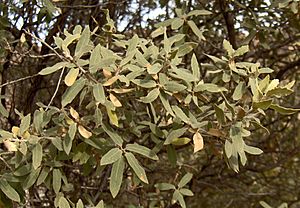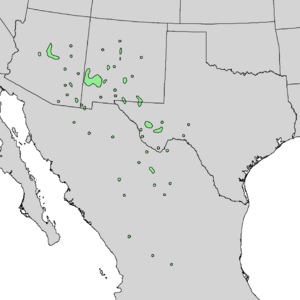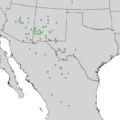Gray oak facts for kids
Quick facts for kids Gray oak |
|
|---|---|
 |
|
| Conservation status | |
| Scientific classification | |
| Genus: |
Quercus
|
| Species: |
grisea
|
 |
|
| Natural range | |
The Gray Oak (also called shin oak or scrub oak) is a type of oak tree or large bush found in North America. It belongs to the white oak family. This plant can be either deciduous (meaning its leaves fall off in certain seasons) or evergreen (meaning its leaves stay green all year).
Gray oaks grow naturally in the mountains of the southwestern United States and northern Mexico. Sometimes, the Gray Oak mixes its genes with other oak species where their living areas overlap. This creates new kinds of oak trees that share features from both parents.
Contents
Where Do Gray Oaks Live?
The Gray Oak is found in the mountains of the southwestern United States. This includes parts of western Texas, New Mexico, Arizona, Colorado, and the Oklahoma Panhandle. You can also find it in northern Mexico, in states like Sonora, Sinaloa, Chihuahua, Durango, Coahuila, San Luis Potosí, Zacatecas, and Hidalgo.
Even though it might be hard to find in some places, the Gray Oak is quite common in the Trans-Pecos area of Texas.
What Does a Gray Oak Look Like?
The Gray Oak, known scientifically as Quercus grisea, can look different depending on where it grows. In dry places, it might grow as a large bush with many stems. But where there's enough rain, it can become a medium-sized tree. These trees can grow up to about 65 feet (20 meters) tall. They often have a crown of branches that look a bit twisted.
The trunk of a Gray Oak can be up to 2 feet (60 cm) wide. Its bark is light gray and has cracks and fissures, looking like small plates. The smaller branches, called twigs, are strong and a light reddish-brown color, covered with soft, grayish fuzz.
The leaves of the Gray Oak are special. They are arranged alternately along the branch and feel leathery. They are long and oval-shaped, with smooth edges or just a few rough teeth. The top side of the leaves is grayish-green, and the underside feels like felt. Sometimes, if winter is very dry, these leaves might fall off.
In spring, at the same time new leaves appear, the Gray Oak produces flowers. The male flowers look like yellowish-green strings called catkins. The female flowers are small spikes that grow where the leaves meet the stem. The acorns, which are the tree's seeds, grow in cups that are covered with small scales and fine hairs. These cups are about half as long as the acorns themselves. The light brown acorns usually grow alone or in pairs.
Where Do Gray Oaks Grow Best?
Gray Oaks like to grow at high elevations, from about 4,000 to 9,000 feet (1,200 to 2,700 meters) above sea level. You can find them in valleys, on rocky slopes, and along the banks of streams. They do very well in places that are semi-arid. This means they like mild winters, dry springs, and hot summers.
This tree can also spread by sending up new shoots from its roots. This is a type of asexual reproduction. Because of this, Gray Oaks can sometimes form thick patches of trees or bushes.
Gray Oaks often grow alongside other types of oaks and plants. Some of these include different kinds of juniper, Mexican pinyon (Pinus cembroides), pinyon pine (Pinus edulis), fendlerbush (Fendlera rupicola), bushy sage (Salvia lycioides), Texas madrone (Arbutus xalapensis), Fremont barberry (Mahonia fremontii), Louisiana sagewort (Artemisia ludoviciana), and soaptree yucca (Yucca elata).
Images for kids
See also
 In Spanish: Quercus grisea para niños
In Spanish: Quercus grisea para niños



